VARIETALS
Feudo Disisa has always embraced the "strategic" choice of combining native vines with international varietals, confident in the knowledge that a truly distinctive terroir always plays a crucial part in defining the varietal expression of each vine. A viticultural kaleidoscope of absolute interest, setting a high standard for the entire Monreale DOC..
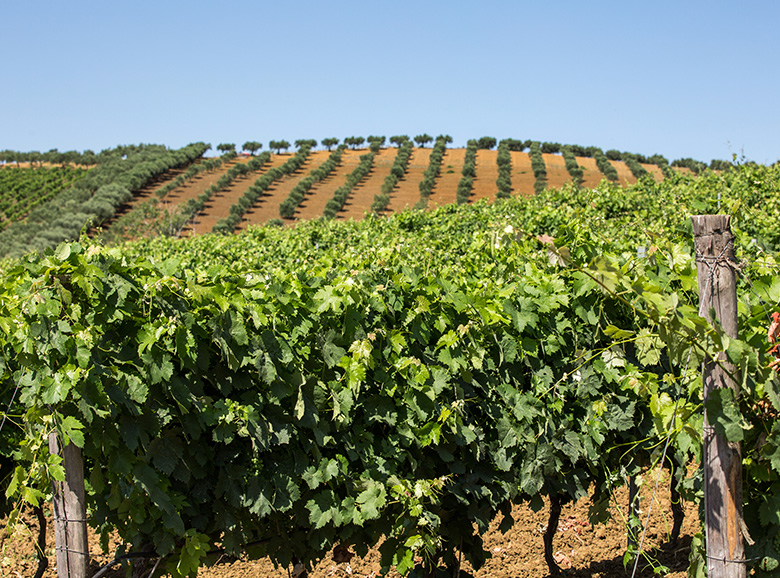
It was in the early 1980s that the Di Lorenzo family – in collaboration with the Sicilian Institute for Vine and Wine – began experimenting with the introduction of several international varietals, with great success. An achievement which attests the pioneering spirit of this family, in an area full of history linked to agriculture and, in particular, to fruit-bearing tree crops.
A vision that the Di Lorenzo family, over three generations, has fulfilled by accruing, harvest after harvest, a meticulous knowledge of the climate/soil/vine interaction of the estate, marking a new path and becoming a model of precision viticulture. This is the keystone of the agronomic management of all Feudo Disisa vineyards, inspired by one rule: wines are made in the vineyard. The ampelographic profile of the estate is very articulated: vineyards implanted over a 40-year period, by operating a mass selection of the vines which have better acclimatized and have consistently produced top quality grapes.
Today Feudo Disisa produces and vinifies its own grapes exclusively, guaranteeing total traceability from the vineyard to the final product. Grillo, Insolia, Catarratto, Nero d'Avola and Perricone, but also Syrah, Cabernet Sauvignon, Merlot and other non-native varieties, all grown on a total area of over 150 hectares.
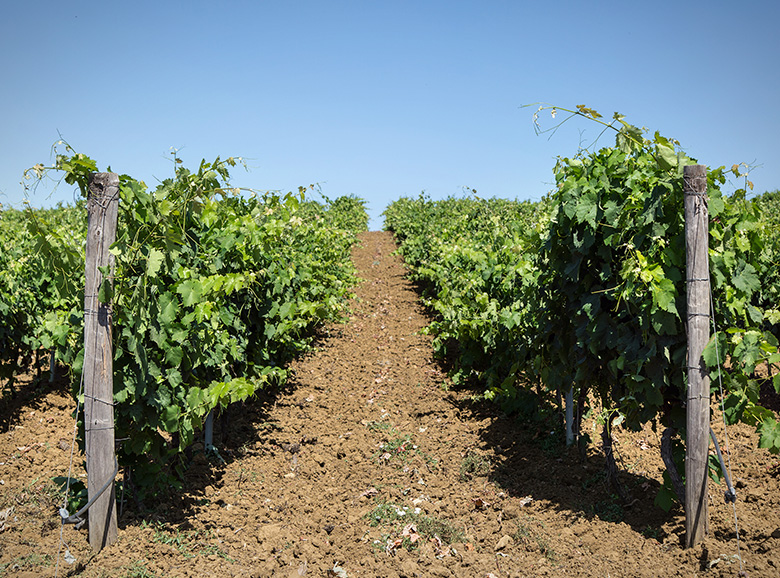

The training system of choice is the espalier, while the vine density is differentiated by varietal and averages at 4.500 plants per hectare. The vineyards are over twenty years old on average, with some younger plants obtained from the massal selection of older vineyards. The pruning systems adopted are the Guyot or the spurred cordon, depending on the year’s target yield for each plant, the season’s climatic trend and the planned vinification of each varietal – the company’s crus and some fine varieties such as Perricone and Insolia do not exceed one kilo per vine. Since 2020, Feudo Disisa has adopted a non-invasive pruning system to preserve and improve the vegetative-productive development of the vines. This will ensure healthy plants, an extended life cycle and a carefully balanced production, preserving the integrity of the older vineyards.
Feudo Disisa has always embraced the "strategic" choice of combining native vines with international varietals, confident in the knowledge that a truly distinctive terroir always plays a crucial part in defining the varietal expression of each vine. A viticultural kaleidoscope of absolute interest, setting a high standard for the entire Monreale DOC.

It was in the early 1980s that the Di Lorenzo family – in collaboration with the Sicilian Institute for Vine and Wine – began experimenting with the introduction of several international varietals, with great success. An achievement which attests the pioneering spirit of this family, in an area full of history linked to agriculture and, in particular, to fruit-bearing tree crops.

A vision that the Di Lorenzo family, over three generations, has fulfilled by accruing, harvest after harvest, a meticulous knowledge of the climate/soil/vine interaction of the estate, marking a new path and becoming a model of precision viticulture. This is the keystone of the agronomic management of all Feudo Disisa vineyards, inspired by one rule: wines are made in the vineyard. The ampelographic profile of the estate is very articulated: vineyards implanted over a 40-year period, by operating a mass selection of the vines which have better acclimatized and have consistently produced top quality grapes.
Today Feudo Disisa produces and vinifies its own grapes exclusively, guaranteeing total traceability from the vineyard to the final product. Grillo, Insolia, Catarratto, Nero d'Avola and Perricone, but also Syrah, Cabernet Sauvignon, Merlot and other non-native varieties, all grown on a total area of over 150 hectares.

The training system of choice is the espalier, while the vine density is differentiated by varietal and averages at 4.500 plants per hectare. The vineyards are over twenty years old on average, with some younger plants obtained from the massal selection of older vineyards. The pruning systems adopted are the Guyot or the spurred cordon, depending on the year’s target yield for each plant, the season’s climatic trend and the planned vinification of each varietal – the company’s crus and some fine varieties such as Perricone and Insolia do not exceed one kilo per vine. Since 2020, Feudo Disisa has adopted a non-invasive pruning system to preserve and improve the vegetative-productive development of the vines. This will ensure healthy plants, an extended life cycle and a carefully balanced production, preserving the integrity of the older vineyards.

VITICULTURE AT FEUDO DISISA
Wine is made in the vineyard. All management practices are carried out following this essential principle. Knowledge of the area and its micro-zones, observation and careful monitoring of the vegetative-productive development of each plant, collection and analysis of climatological data, all performed by a constantly engaged and professionally qualified team, striving to achieve consistent quality standards year after year.
Hence, the company practices a proximity viticulture structured around careful and diversified activities and interventions for each area and vine. Every operation in the vineyards is planned in order to achieve productive balance, healthy grapes, and the maximum expressive potential of each vine: a production philosophy capable of enhancing the unique character of the pedoclimatic and zonal context of the Feudo Disisa estate.
All these viticultural practices require important manual skills: the pruning, the binding of the shoots, leaf removal when needed, as well as tipping and thinning, traditionally performed only on the Perricone vines, and of course the harvesting of the grapes, diversified according to each varietal and its ideal ripening time. At Feudo Disisa, vine cuttings are shredded and turned into mulch to improve soil quality, the rows are ploughed in the pre-budding stage to encourage spontaneous ground cover and tilled during the veraison phase.
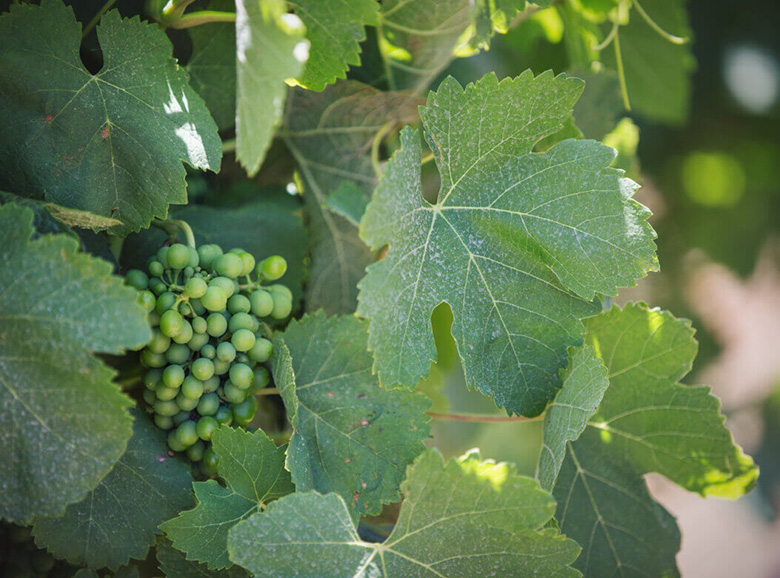
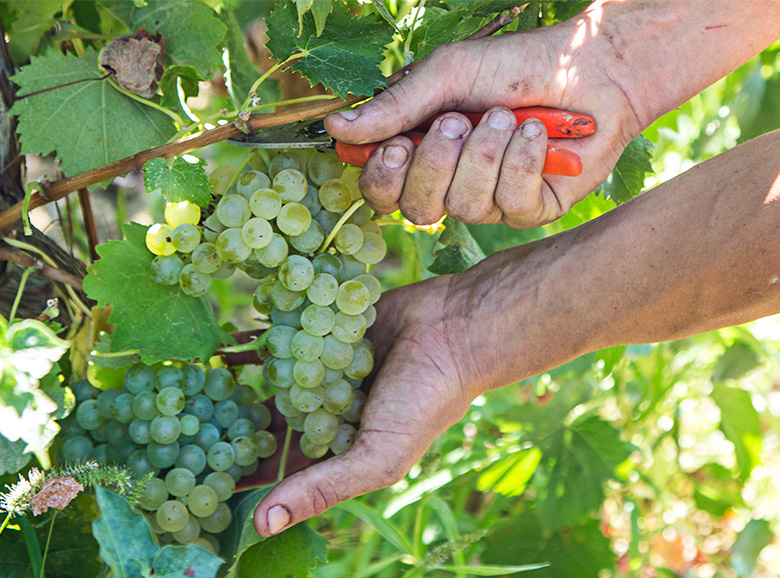
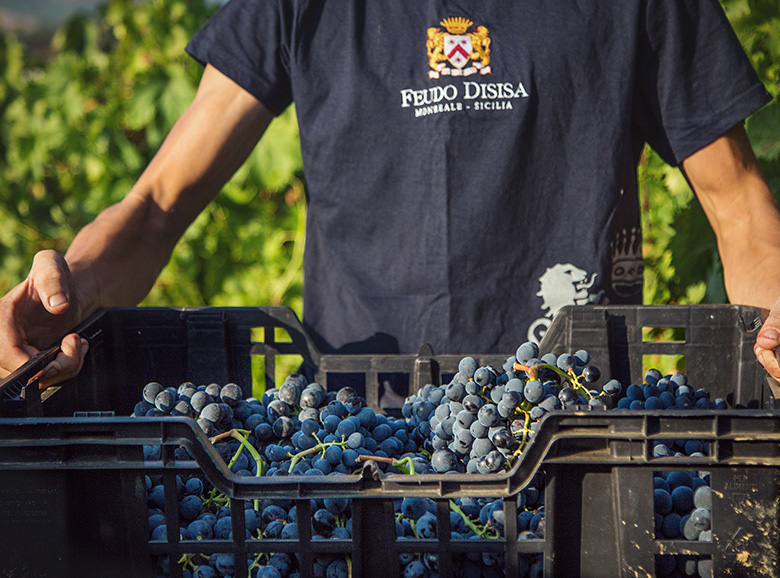
HARVEST TIME AT FEUDO DISISA
The harvest takes place in the space of just over two months, the grapes are handpicked and tasted in the vineyard and subsequently lab tested to assess their pH, acidity and sugar content. If the vintage is regular, we begin harvesting our Chardonnay and Sauvignon Blanc in the very first days of August, followed, in the second decade, by Grillo. In the third decade of August, we proceed with the picking of Fiano, Merlot and Syrah. Early September it is the time to harvest Insolia and Nero d'Avola, followed by Catarratto. The varietals which need to be harvested for last, between late September and early October, are Perricone, Cabernet Sauvignon and Cabernet Franc.
THE REDISCOVERY OF PERRICONE
Unfairly regarded as a minor grape for far too long, this heirloom vine is native to western Sicily, grown mostly in the countryside of Palermo and Trapani. Perricone was once one of the most widely grown native varietals as it was essential for the production of Marsala wine, especially in the ruby version, blended with other autochthonous grapes of the Trapani area and the hills enclosed between the Belìce and Jato valleys. These precious vines, however, were destroyed by the phylloxera plague of the late nineteenth century. In the Trapani area Perricone is also known as Pignatello, as it grows well on soils rich in clay, which was also used for the making of earthenware, known locally as 'pignate': common terracotta pots, made particularly sturdy from the abundance of iron in the clay. With the decline of Marsala wine, the vine gradually lost importance and was gradually abandoned. The Di Lorenzo family was among the first companies to rediscover its value and viticultural potential. The recovery of the Perricone vine in practiced in a few areas located in the western part of Sicily, mostly using a low-density training system and short or mixed pruning. In the Feudo Disisa estate, Perricone is mostly upwards-trained and vertical-trellised. Perricone is a consistent and reliable wine vine both in terms of yield and longevity: two variables that tend to balance each other out. It is a vine of excellent vigour and resistance to dry climates. Budbreak happens early, but the ripening overall tends to take quite long. The bunches are winged and the berries are compact, forming medium-sized and typically conical-pyramidal clusters, with thick, pruinose skins and an intense dark blue, almost black, colour.
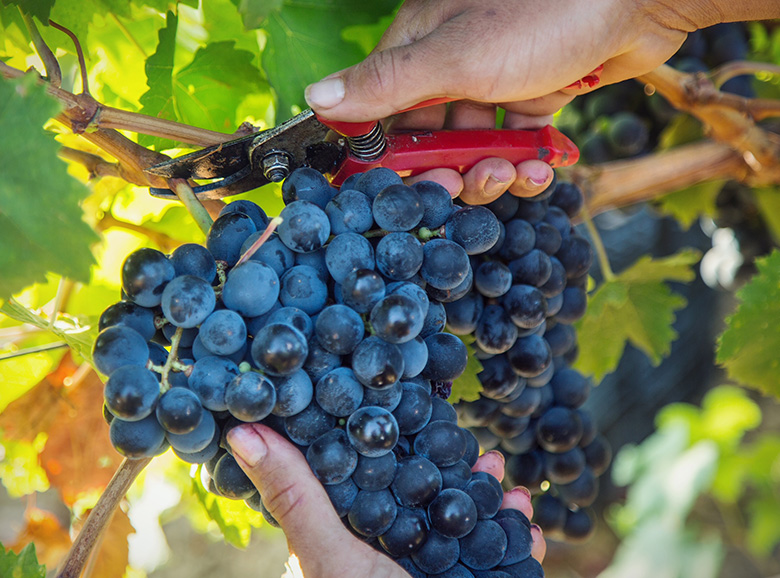

VITICULTURE AT FEUDO DISISA
Wine is made in the vineyard. All management practices are carried out following this essential principle. Knowledge of the area and its micro-zones, observation and careful monitoring of the vegetative-productive development of each plant, collection and analysis of climatological data, all performed by a constantly engaged and professionally qualified team, striving to achieve consistent quality standards year after year.
Hence, the company practices a proximity viticulture structured around careful and diversified activities and interventions for each area and vine. Every operation in the vineyards is planned in order to achieve productive balance, healthy grapes, and the maximum expressive potential of each vine: a production philosophy capable of enhancing the unique character of the pedoclimatic and zonal context of the Feudo Disisa estate.
All these viticultural practices require important manual skills: the pruning, the binding of the shoots, leaf removal when needed, as well as tipping and thinning, traditionally performed only on the Perricone vines, and of course the harvesting of the grapes, diversified according to each varietal and its ideal ripening time. At Feudo Disisa, vine cuttings are shredded and turned into mulch to improve soil quality, the rows are ploughed in the pre-budding stage to encourage spontaneous ground cover and tilled during the veraison phase.



HARVEST TIME AT FEUDO DISISA
The harvest takes place in the space of just over two months, the grapes are handpicked and tasted in the vineyard and subsequently lab tested to assess their pH, acidity and sugar content. If the vintage is regular, we begin harvesting our Chardonnay and Sauvignon Blanc in the very first days of August, followed, in the second decade, by Grillo. In the third decade of August, we proceed with the picking of Fiano, Merlot and Syrah. Early September it is the time to harvest Insolia and Nero d'Avola, followed by Catarratto. The varietals which need to be harvested for last, between late September and early October, are Perricone, Cabernet Sauvignon and Cabernet Franc.
THE REDISCOVERY OF PERRICONE
Unfairly regarded as a minor grape for far too long, this heirloom vine is native to western Sicily, grown mostly in the countryside of Palermo and Trapani. Perricone was once one of the most widely grown native varietals as it was essential for the production of Marsala wine, especially in the ruby version, blended with other autochthonous grapes of the Trapani area and the hills enclosed between the Belìce and Jato valleys. These precious vines, however, were destroyed by the phylloxera plague of the late nineteenth century. In the Trapani area Perricone is also known as Pignatello, as it grows well on soils rich in clay, which was also used for the making of earthenware, known locally as 'pignate': common terracotta pots, made particularly sturdy from the abundance of iron in the clay. With the decline of Marsala wine, the vine gradually lost importance and was gradually abandoned. The Di Lorenzo family was among the first companies to rediscover its value and viticultural potential. The recovery of the Perricone vine in practiced in a few areas located in the western part of Sicily, mostly using a low-density training system and short or mixed pruning. In the Feudo Disisa estate, Perricone is mostly upwards-trained and vertical-trellised. Perricone is a consistent and reliable wine vine both in terms of yield and longevity: two variables that tend to balance each other out. It is a vine of excellent vigour and resistance to dry climates. Budbreak happens early, but the ripening overall tends to take quite long. The bunches are winged and the berries are compact, forming medium-sized and typically conical-pyramidal clusters, with thick, pruinose skins and an intense dark blue, almost black, colour.


